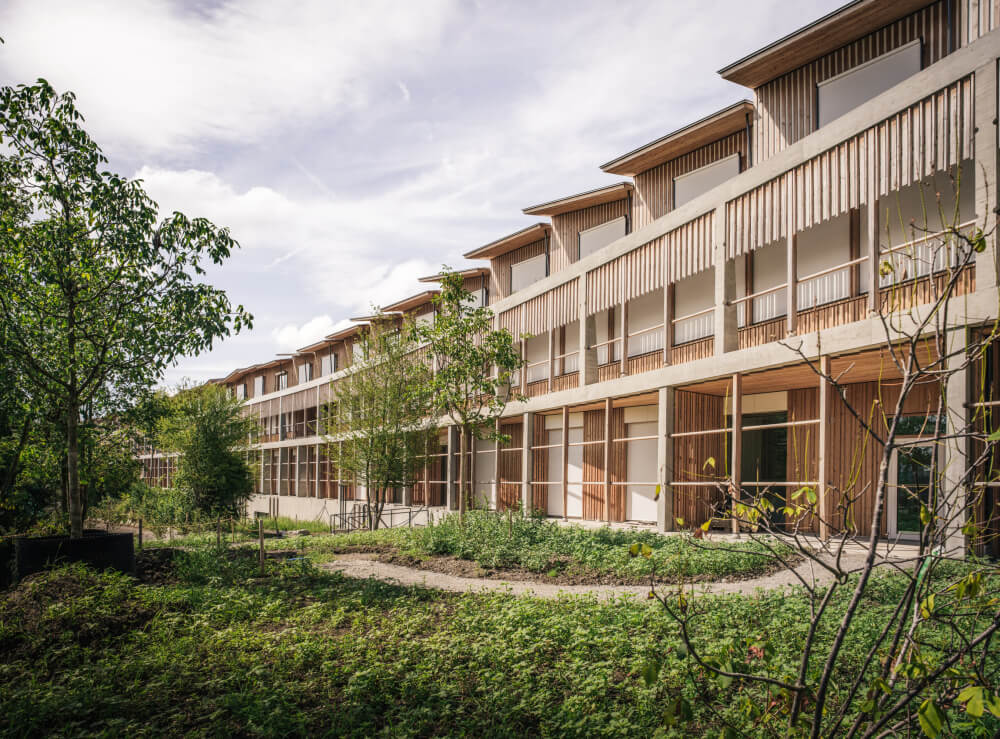[ad_1]
A new healthcare facility by Herzog & de Meuron was designed “to function like a town,” the world-renowned architects shared in a statement. The Swiss firm’s University Children’s Hospital of Zurich is now complete; it constitutes the “largest facility for children and adolescents” in Switzerland. The first patients will be welcomed in November, hospital officials said.
Just below a foot hill called Burgholzli, Herzog & de Meuron ideated two buildings: An acute-care hospital and research and teaching facility. The acute-care hospital is a 3-story building made of wood and concrete, and the research and teaching facility is a 5-story cylindrical one finished with a white lacquer, not unlike Frank Lloyd Wright’s Guggenheim Museum. The two buildings are just a short walk from one another, divided by an access road.
Over 250 trees were planted throughout the campus. In its materiality, facade rhythm, and interior finishes, the new acute-care hospital echoes Alvar Aalto’s Paimio Sanatorium, completed in 1932. At University Children’s Hospital of Zurich, architects at Herzog & de Meuron undertook a similar pursuit as Aalto almost a century ago: Can architecture abet the healing process?
A Holistic Approach
The hospital site just south of Zurich’s city center is a historic one: It has myriad healthcare buildings from different eras, the oldest dating back to 1869. The new architecture by Herzog & de Meuron respects and responds to this context.
Previously, pediatric care facilities were scattered throughout Zurich, many in Hottingen. The new University Children’s Hospital of Zurich centralized multiple disparate programs into one location. Hospital officials have called it “a century-long project.”
“In collaboration with many other specialists, we were able to stand by and advise the Eleonoren Foundation throughout all levels of the project, from city planning to architecture, vegetation, materials and even medical fittings and furnishings,” said Christine Binswanger, a partner at Herzog & de Meuron. “The result is a holistically conceived, functional building that is calm and quiet despite its diversity.”
In plan, the acute-care hospital is a bar building pinched in the middle. A central corridor runs through the 3-story building that, according to Herzog & de Meuron, functions as the main street on each of its floors. This passage connects users to a network of green courtyards while also providing orientation and daylighting.
The units on the acute-care hospital’s roof “are like individual cottages,” Herzog & de Meuron added. Interior finishes are humble: Wood slats and furniture, and concrete floors and columns. A sculptural stair made of concrete connects the floors with port hole windows and custom wooden handrails.
“The curved, 3-story main facade with its endearing small-scale wooden houses and variously sloped roofs offers a friendly and warm welcome to young patients and their families. The acute care hospital is organized like a town—with courtyards, streets, alleys, and squares,” Pierre de Meuron shared.
“These, along with the thoughtful use of wood and carefully placed art installations, provide clear and memorable orientation, plenty of daylight, and a connection to nature,” de Meuron continued. “The spatial diversity, with views both inside and out, also offers spaces for children, teenagers, and their families to stay and play, as well as restful break areas for hospital staff.”
“Architecture can contribute to healing”
To the north, the new research and training facility consists of a white cylindrical 5-story building with an atrium in the middle. There are three lecture halls interspersed in the lower levels surrounded by seminar rooms and study areas. Research areas are perched above these spaces.
“Ironically, hospitals all over the world and even in Switzerland are often the ugliest places,” Jacques Herzog said. “For the past 20 years, we have zeroed in on this issue, because we are convinced that architecture can contribute to the healing process; it can make a substantial difference.
Herzog continued: “Here at the Children’s Hospital, people can see for themselves how daylight coming in from outside and variations in proportion can animate and change a room, how plants and vegetation can blur the distinction between inside and outside, and how materials are not just beautiful to look at but also pleasing to the touch. We designed all these things with conscious intent so that people can perceive them, sense them and ultimately feel better. Architecture can contribute to healing.”
[ad_2]
Source link

